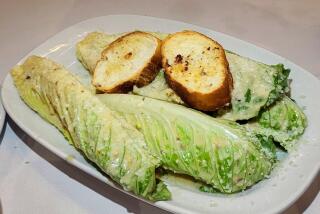Score One for the Crusaders
- Share via
Everybody knows the Middle East influenced European cooking during the crusades. Actually, historians now think the influence mostly came by way of Spain and Sicily, where the Moors sat right on Europe’s doorstep for hundreds of years, but culinary influence did take place as a direct result of the crusades.
Here’s the thing: It didn’t all go in one direction. Three 13th century Arabic cookbooks give recipes for sauces called sals or salsa, which really can’t be anything but the same Latin word that became “sauce” in English.
Some of these medieval Arab salsas were clearly European. The one consisting of bread crumbs soaked in vinegar and mixed with spices was the kind of thing you could buy by the bucket in Paris.
But most of the salsas were based on ground nuts mixed with an acid ingredient such as vinegar, lemon juice or sour pomegranate juice and then spiced. This (not very European) combination thickens up when you mix it, and the recipes often refer to a certain salsa consistency, so that might have been what made salsa salsa by Saracen standards. Except that there had already been ground-nut sauces in the Middle East under the name of siba^gh, and there were other Arab salsas that weren’t thickened.
Hmm. A puzzle. Maybe the answer is in the fact that these salsas were always served with fish. The European Christians, unlike the Muslims, were obliged to eat fish on fast days, so they probably had a better-developed fish cooking tradition. Ask the experts: If they call what they put on fish salsa, rather than siba^gh, you call it salsa too.

